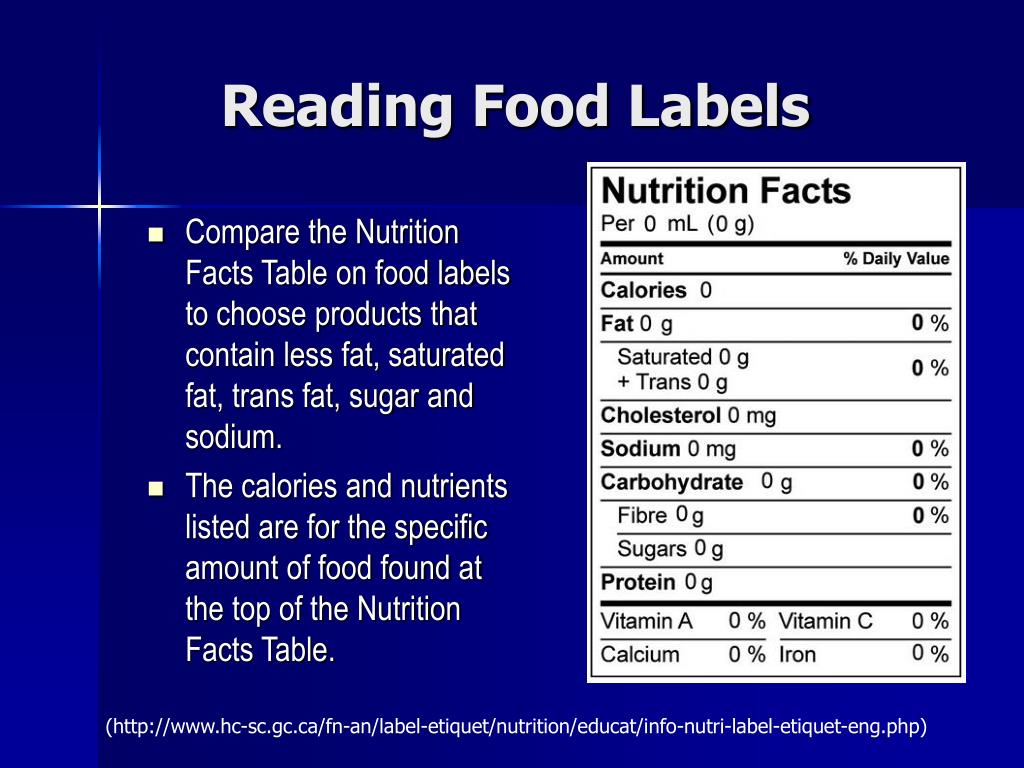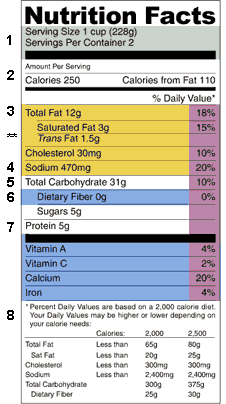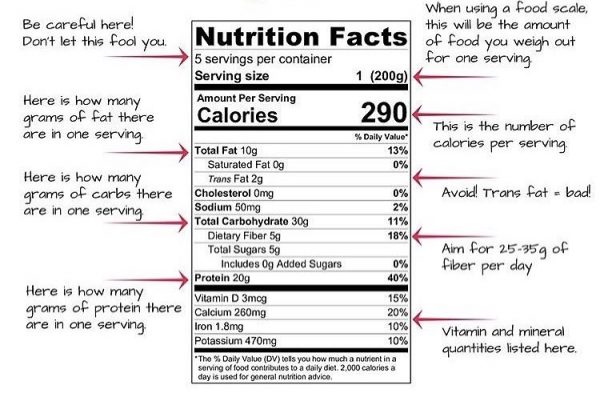38 reading calories on food labels
How To Read A Food Nutrition Label | Gobble For example, the USDA recommends that most people get 1,000 mg of calcium per day. So, if a serving of food contains 100 mg of calcium, this means the serving contains 10% Daily Value of calcium. The same applies to items on the food label you may want to avoid, like fat and cholesterol. For example, 15 grams is 20% Daily Value for total fat. 4-Week Emergency Food Supply (2,000+ calories/day) Jul 08, 2022 · CALORIES = ENERGY = SURVIVAL. Our 4-Week Food Supply provides one person with an average of over 2,000 calories per day for 28 days. Remember, calories are crucial to survival! Other companies skimp on calories, which isn’t just wrong—it’s reckless. You won’t be satisfied with 1,500 calories, and 1,300 calories will leave you starving.
Understanding Ingredients on Food Labels - American Heart Association Food labels are an important source of information about calories and the nutritional value of the foods you eat, a crucial tool in building a heart-healthy diet. The Nutrition Facts information is always displayed in the same orderly fashion and helps you understand how much of certain nutrients that you need to limit are contained in the ...
Reading calories on food labels
Food Labels 101: Understanding the Nutrition Facts Label Nutrition labels can be a great tool for managing a heart healthy diet, which makes it very important that you understand what you're looking at when you read a label. Nutrition labels are based on a daily 2,000 calorie diet. Depending on your age, gender and activity level, you may need to consume more or less than 2,000 calories per day, so ... Food Labels | CDC All the numbers on this label are for a 2/3-cup serving. This package has 8 servings. If you eat the whole thing, you are eating 8 times the amount of calories, carbs, fat, etc., shown on the label. Total Carbohydrate shows you types of carbs in the food, including sugar and fiber. Choose foods with more fiber, vitamins, and minerals. This Is How to Read a Nutrition Facts Label on the Keto Diet Depending on the daily carb intake you've determined for yourself to stay in ketosis, this is a quick way to determine whether you have room in your daily eating plan for a particular food. (Remember, a ketogenic diet is typically a ratio of about 70-75% fat, 15-25%+ protein, and 5% or less of calories from carbs.)
Reading calories on food labels. How to Read Nutrition Labels - Verywell Fit U. S. Food and Drug Administration (FDA) The column on the right side of the nutrition label has numbers displayed in percentages. The numbers listed under "% Daily Value" tell you how much a particular nutrient contributes to your total daily diet if you consume 2,000 calories per day. How to Read Nutrition Facts | Food Labels Made Easy - YouTube To support our channel and level up your health, check out:Our Fast Weight Loss Course: B... The Basics of the Nutrition Facts Label Step 4: Check Out the Nutrition Terms. Low calorie: 40 calories or less per serving. Low cholesterol: 20 milligrams or less and 2 grams or less of saturated fat per serving. Reduced: At least 25% less of the specified nutrient or calories than the usual product. Good source of: Provides at least 10 to 19% of the Daily Value of a particular ... What Do Calories Mean in Food and Exercise? - Verywell Fit Oct 12, 2021 · Understanding Calories in Food . Calories in food are grouped as fats, alcohol, carbohydrates, and proteins. Different nutrients have more or fewer calories packed into the same weight (higher or lower calorie density). Nutrition labels in …
PDF How to Read the Food Label - Risk Services Always check the serving size (see sample label on page 2). Calories. This is the number of calories you'll eat in . one serving of a food. Calories needed each day depends on your age, sex, height, weight, and amount of physical activity. Estimates range from 1,600 to 2,400 calories for women and 2,000 to 3,000 calories for men. If you're ... How To Read Food and Beverage Labels | National Institute on Aging At the top of the Nutrition Facts label, you will find the total number of servings in the container and the food or beverage's serving size. The serving size on the label is based on the amount of food that people may typically eat at one time and is not a recommendation of how much to eat. Read more about serving and portion sizes. Reading and Understanding Food Labels and Nutrition Info - Beaumont Health Carbohydrates are the main source of energy during most physical activity. Carbohydrates should comprise 50-75 percent of your calories, or about 200-500 grams per day depending on your caloric requirement. Fiber may play as much of a role in disease prevention as fat. Aim for at least 30 grams per day. How to read food labels: MedlinePlus Medical Encyclopedia Always check the serving size first. All the information on the label is based on the serving size. Many packages contain more than 1 serving. For example, the serving size for spaghetti is most often 2 ounces (56 grams) uncooked, or 1 cup (0.24 liters) cooked. If you eat 2 cups (0.48 liters) at a meal, you are eating 2 servings.
Food labels - NHS These labels provide information on the number of grams of fat, saturated fat, sugars and salt, and the amount of energy (in kJ and kcal) in a serving or portion of the food. But be aware that the manufacturer's idea of a portion may be different from yours. Some front-of-pack nutrition labels also provide information about reference intakes. Food Labels (for Teens) - Nemours KidsHealth A food with 5% or less of a nutrient is low in that nutrient. A food with 10%–19% of a nutrient is a good source of that nutrient. A food with 20% or more of a nutrient is high in that nutrient. The information on food labels is based on an average adult diet of 2,000 calories per day. Quick Tips for Reading the Nutrition Facts Label shows how much a nutrient in a serving of the food contributes to a total daily diet. As a general guide: 5% DV ... Quick Tips for Reading the Nutrition Facts Label The Nutrition Facts Label Tip ... Understanding food labels - Canada.ca Find information on food labels and how to understand them. Learn about nutrition facts tables, serving size, list of ingredients, % daily value and nutrition claims.
10 Best Images of Fast Food Worksheets - Fast Food Activity, Printable Food Worksheets and Food ...
How to read food labels - Heart Foundation NZ The star rating is calculated using an algorithm that takes into consideration a number of positive and negative nutrients for a particular food. The positive elements include protein, fibre, fruit, vegetable, nut, seed and legume content. The negative elements include energy, sodium, saturated fat, and sugar.
How to Read a Nutrition Facts Label - Everyday Health How to Read a Nutrition Facts Label. First, know that, as the label itself states, the included nutritional info is based on a 2,000-calorie-a-day diet. Your personal nutritional needs may vary ...
How to read nutrition facts on food labels? Food Labels to Read. Step 1: Determine the number of servings and the number of calories per serving. The serving size determines all of the information on a food label. Step 2: Determine the amount of fat in the dish. Step 3: Determine the amount of cholesterol in your system. Step 4: Make sure the sodium level is correct (salt).
How To Read Food Labels - Fit Me Solution But because the current Daily Value for calcium on food labels is 1000 milligrams (and the proposed is 1300), 1 milligram of calcium is a negligible amount. Front-of-Package Labels. Some consumers find the many numbers on Nutrition Facts panels overwhelming. They want an easier and quicker way to interpret information and select products.
How to Understand and Use the Nutrition Facts Label | FDA The following label-reading skills are intended to make it easier for you to use the Nutrition Facts labels to make quick, informed food decisions to help you choose a healthy diet.
How To Read Food Labels - 10 Tips | Pritikin Program For Eating Right Don't be fooled by claims like "99% fat-free" soup or "2% fat" milk. They're based on percent of weight, not percent of calories. So that can of 99% fat-free soup may actually have 77% of its calories from fat, or more. And 2% fat milk actually has about 34% of total calories from fat; 1% milk has about 23% calories from fat. 7.

PPT - Nutrition and Older Adults: Issues among Community and Long-Term Care Residents PowerPoint ...
How to Read Food Labels, Calories on Food Labels Food Label Terms. The FDA has created rules regarding the use of certain terms on food labels. To understand what the food actually contains, you must know what these terms mean. Calorie Terms "Low Calorie" = Contains no more than 40 calories per serving. "Reduced Calorie" = Contains 25% fewer calories per serving than regular product

Understanding Food Labels - Food Ingredient Facts regarding Understanding Food Labels22594 ...
How to Read Nutrition Facts Labels the Right Way - GoodRx A good goal is to aim to consume the following amounts of protein during the day: At each meal: 20 to 30 g (about one small chicken breast or fish filet) With snacks: About 10 to 15 g (about two eggs or half a cup of Greek-style yogurt) Also, keep in mind that more isn't necessarily better.
A Guide to Reading Food Labels - University of Rochester Feb 27, 2013 · of calories from fat. You should limit the number of calories from fat to 20-35% of your total daily calories. In the sample label, there are 250 calories in one serving and 110 calories from fat. This means almost 50% of the calories in a single serving of this food come from fat. Due to its high fat content, this food is not a healthy choice.
Reading Food Labels - Food Smart Colorado Daily Value is the amount of a nutrient you should get each day. The % Daily Values tell you what percent of this daily amount is in one serving. 5% Daily Value or less means that a food is a low source of a nutrient. 20% Daily Value or more means that a food is a high source of a nutrient. Limit sodium, sugar, and saturated fat, but get enough ...
How To Read Food and Beverage Labels | National Institute on Aging Feb 24, 2022 · Reading food labels can help you make smart food choices. Learn how to read and understand the product date, ingredient list, and Nutrition Facts label. ... If you are eating fewer calories per day and eat one serving, your % DV will be higher than what you see on the label. Some nutrients on the Nutrition Facts label do not have a % DV, but ...
Understanding Food Nutrition Labels | American Heart Association Remember that the information shown in the label is based on a diet of 2,000 calories a day. You may need less or more than 2,000 calories depending upon your age, gender, activity level, and whether you're trying to lose, gain or maintain your weight. When the Nutrition Facts label says a food contains "0 g" of trans fat, but includes ...
Reading Nutrition Labels - Cronometer Reading Nutrition Labels Hilary March 31, 2021 23:00; ... see on nutrition labels is a standardized value used for nutrition labels to help people better understand amounts on labels. In the Cronometer Calories Summary, the Nutrient Targets show your nutrition targets for the day. Each target has an optional minimum and maximum value.
Use food labels - Canada's Food Guide Oct 14, 2020 · Using food labels can help you compare and choose products so you can make an informed choice. On this page Benefits of using food labels Changes to food labels How to use food labels Benefits of using food labels Food labels provide information you can use to make informed choices about foods and drinks at the grocery store and at home. Food labels …
The Basics of the Nutrition Facts Label Mar 04, 2022 · The following is a quick guide to reading the Nutrition Facts label. Step 1: Start with the Serving Size ... Daily Values are average levels of nutrients based on a person who eats 2,000 calories a day. A food item with a 5% DV of fat provides 5% of the total fat that a person who needs 2,000 calories a day should eat. ... Nutrition Facts and ...
How To Read Nutrition Food Labels - Superfood Pharmacist The nutrition facts label includes a column displaying the Percent Daily Value for the listed nutrients. The Percent Daily Value indicates how much one serving of the food item contributes toward the recommended daily value for that nutrient (fat, carbohydrates, vitamin D, etc.) based on a 2000-calorie diet. For example: If an individual's needs are 2000 calories per day, one serving of the ...











Post a Comment for "38 reading calories on food labels"